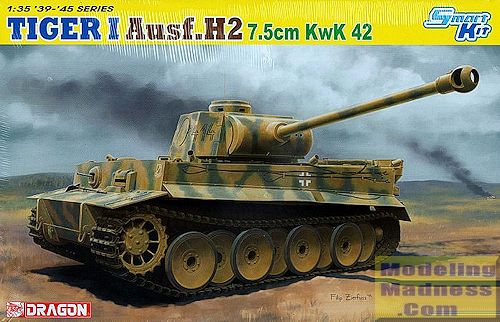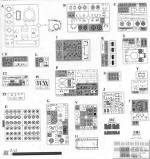
Dragon 1/35 Tiger I ausf H2
| KIT #: | 6683 |
| PRICE: | $76.00 SRP |
| DECALS: | Several options |
| REVIEWER: | Scott Van Aken |
| NOTES: | Smart kit with DS tracks |

| HISTORY |
Tiger I is the common name of a German heavy tank developed in 1942 and used in World War II. The final official German designation was Panzerkampfwagen VI Tiger Ausf.E, often shortened to Tiger. It was an answer to the unexpectedly impressive Soviet armour encountered in the initial months of the Axis invasion of the Soviet Union, particularly the T-34 and the KV-1. The Tiger I gave the Wehrmacht its first tank mounting the 88 mm gun in its first armoured fighting vehicle-dedicated version: the KwK 36. During the course of the war, the Tiger I saw combat on all German battlefronts. It was usually deployed in independent tank battalions, which proved highly effective.
Both Henschel and Porsche were involved in preliminary design work for this heavy tank. In mid-1941, Henschel decided to build two prototypes of its VK 4501(H) design that were armed with an 88mm KwK.36 cannon and a 75mm KwK.42 cannon, and these were known respectively as H1 and H2. The Rheinmetall L/70 gun of the H2 was mounted in a newly designed turret similar to that eventually used on the Panther Ausf.D and Ausf.A. Only a wooden mock-up of the turret was ever made, as Henschel eventually decided to focus on the H1 type in late 1941.
While the Tiger I was an excellent design, it was over-engineered, using expensive materials and labour-intensive production methods. Only 1,347 were built between August 1942 and August 1944. The Tiger was prone to certain types of track failures and breakdowns, and limited in range by its high fuel consumption. It was expensive to maintain, but generally mechanically reliable. It was also difficult to transport, and vulnerable to immobilization when mud, ice and snow froze between its overlapping and interleaved Schachtellaufwerk-pattern road wheels in both rasputitsa and succeeding winter weather conditions, often jamming them solid. In 1944, production was phased out in favour of the Tiger II.
The tank was given its nickname "Tiger" by Ferdinand Porsche, and the Roman numeral was added after the later Tiger II entered production. The initial official German designation was Panzerkampfwagen VI Ausführung H (‘Panzer VI version H’, abbreviated PzKpfw VI Ausf. H), with ordnance inventory designation SdKfz 182, but the tank was redesignated as PzKpfw VI Ausf. E in March 1943, with ordnance inventory designation SdKfz 181.
Today, only a handful of Tigers survive in museums and exhibitions worldwide. The Bovington Tank Museum's Tiger 131 is currently the only one restored to running order.
| THE KIT |
 It seems like Dragon is now going into the prototypes for some of its new German armor kits and it is not surprising as they have done literally hundreds of armor kits over the years.
It seems like Dragon is now going into the prototypes for some of its new German armor kits and it is not surprising as they have done literally hundreds of armor kits over the years.
This one is based on their upgraded Tiger I hull and suspension pieces, with a brand new turret that is very much like that of the Panther series. It also uses the appropriate 75mm KwK.42 cannon. These parts are located on a new sprue 'A'. The rest of the kit is all tried and true bits from Dragon's various Tiger kits. This includes the detailed hull and complex road wheel arrangement. All the suspension bits are molded onto the hull which is fine as little will be seen the the finished project. As this is basically an early hull, some trimming, drilling and filling of bits will be needed.
It wouldn't be a Dragon German armor kit without some photo etch and that is provided by four engine screens. Two other metal bits are included to serve as the wiring to the headlights. The driver's and gunner's hatches have full detail on the inside in case you wish to pose these open for figures. This is not the case for the turret hatches which are designed to be modeled closed. This boxing comes with Dragons deformable styrene tracks, which really speeds the build. These are handed so need to be installed on the proper side.
Instructions include a painting guide for three hypothetical tanks, all operating in Russia during 1943. The decal sheet included offers a variety of turret numbers for you to use. The three options are painted in a manner similar to the box art.
| CONCLUSIONS |
Those who want to have a full collection of Tiger tanks will want to add this one to their display shelves. It is a nice looking tank and should find favor with those wanting to build something a bit different that those who like 'what if' subjects.
| REFERENCES |
http://en.wikipedia.org/wiki/Tiger_I
December 2014 Thanks to www.dragonmodelsusa.com for the preview kit. You can find this kit at your favorite hobby shop or on-line retailer. If you would like your product reviewed fairly and fairly quickly, please contactthe editor or see other details in the